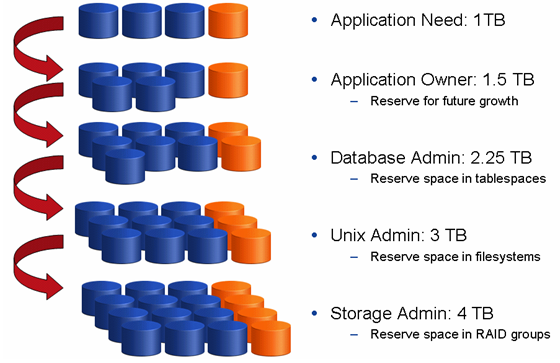This is an article I wrote a while ago (mid 2009), a while after EMC introduced Enterprise Flash Drives (EFD’s) and albeit a bit outdated, it is a valid introduction to Enterprise Flash Drive technology.
It also explains the differences between consumer grade flash (the SSD drive in your laptop or tablet) versus enterprise grade (the stuff that makes business applications screamingly fast)
Enterprise Flash Drive technology
Over the last 30 years, we have seen an enormous improvement in hard disk capacity. Back then a gigabyte drive was quite something and using a state-of-the-art SCSI interface, it could transfer a whopping three megabytes per second!
Currently modern disk drives are smaller and can easily store a terabyte of capacity or more – a 1000-fold improvement! (And the 1.5 and 2 terabyte drives are on the way). With modern fibre channel interfaces, a disk can transfer up to 4 Gigabit (about 400 megabytes) per second which is a 133 times improvement over 30 years!
Fortunately disk drive technology has more or less kept up with Moore’s law for microprocessors regarding capacity and channel bandwidth.
There is a problem, however. First of all the hunger for computer storage is outpacing the increase in disk capacities, so we have to buy more and more disks to satisfy our needs (IDC findings show that the worldwide information created yearly is increasing by about 60% each year).
The second problem is that the access performance of disk drives has not improved that much. In other words, to find information on a disk drive it still requires mechanical movements. The drive arm has to be moved into position over the right disk track and then the disk has to rotate until the data can be accessed by the arm. This takes a few milliseconds and depends largely on the rotational speed of the disks – and this has not improved that much. 30 years ago the regular rotational speed was 3600 rpm, where today’s high-performance drives offer 15,000 rpm – a 4-fold improvement resulting in access times from 24 milliseconds 30 years ago to 6 milliseconds today (note that this is the average time to read data on a random location on the disk if the disk is idle). An important negative side effect of increasing rotational speed is that the power consumption of the drive increases almost exponentially – this is why there were experiments with 20,000 rpm drives but these are not widely adopted into the market. Any faster and the drive will overheat or require special cooling.
Continue reading →

 Maybe you have heard the story of the Monkey Experiment. It is about an experiment with a bunch of monkeys in a cage, a ladder, and a banana. At a certain point one of the monkeys sees the banana hanging up high, starts climbing the ladder, and then the researcher sprays all monkeys with cold water. The climbing monkey tumbles down before even getting the banana, looks puzzled, wait until he’s dry again and his ego back on its feet. He tries again, same result, all monkeys are sprayed wet. Some of the others try it a few times until they learn: don’t climb for the banana or you will get wet and cold.
Maybe you have heard the story of the Monkey Experiment. It is about an experiment with a bunch of monkeys in a cage, a ladder, and a banana. At a certain point one of the monkeys sees the banana hanging up high, starts climbing the ladder, and then the researcher sprays all monkeys with cold water. The climbing monkey tumbles down before even getting the banana, looks puzzled, wait until he’s dry again and his ego back on its feet. He tries again, same result, all monkeys are sprayed wet. Some of the others try it a few times until they learn: don’t climb for the banana or you will get wet and cold.